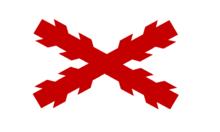Requeté
The Requeté (German: recruit) was founded in 1907 by Joan Maria Roma as a youth organization of Carlism . From 1913 onwards he increasingly turned into the paramilitary arm of the Carlist movement, which remained insignificant until the founding of the second Spanish republic , as a military success of Carlism was unlikely. However, under the changed conditions after 1931, this organization grew significantly; in Navarra alone, the home of the Carlist, the Requeté numbered 10,000 militia officers in 1931 . From 1932 they were also given tactical training by the then colonel and later well-known general of the Spanish Civil War, José Enrique Varela . Weapons could be smuggled across the French border without any problems and largely unmolested by the Spanish government.
When the Spanish Civil War broke out, the Requeté numbered 30,000 men and played an important role in the victory of the nationalists on the Spanish Northern Front. The leader of the Requeté was Fal Conde . Under his successor José Luis Zamanillo , the Carlist movement was forcibly united with the Falangist movement in the " Falange Española Tradicionalista y de las JONS " in 1937 .
The first Navarradivision, in which most of the requetés were united, was considered an elite unit. During the entire war the Carlist provided 41 "Tercios" ( battalions ): 10 from Navarre, 8 from the Basque Country, 8 from Castile, 7 from Andalusia, 6 from Aragon, and one each from Asturias and Catalonia. Her medieval religiosity made her completely fearless in battle. Colonel Ricardo Rada , a Colonel of the Requeté, described the Requetés as follows: They hold a grenade in one hand and the rosary in the other .
Of the 60,000 requetés that witnessed the war in these battalions, around 6,000 never returned.
symbolism
The most important feature of the requetés was the red beret with a gold border. Many of them wore the so-called "ball stopper", a heart of Jesus, over their chests, which showed the strong roots of Carlism in Catholicism. On the left sleeve there was also the Saint Andrew's cross, symbol of the Carlist movement. Since Carlism was primarily a monarchist movement, officers also often wore a white lily on their collars, the symbol of the House of Bourbon .
See also
Web links
Individual evidence
- ^ Antony Beevor: The Spanish Civil War , 2nd edition, ISBN 978-3-442-15492-0 , page 253
- ^ Antony Beevor: The Spanish Civil War , 2nd edition, ISBN 978-3-442-15492-0 , page 253
